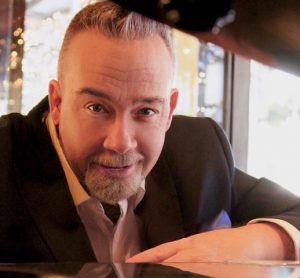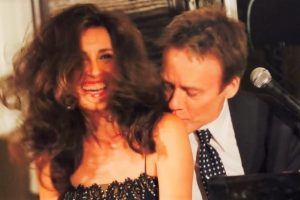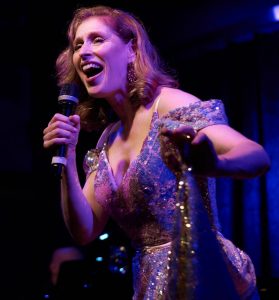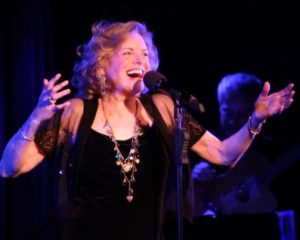Cabaret Singers: Did Their Virtual Performing Experiences Have Any Effect on Their Long-Awaited Return to the Stage?
We began this article with the hypothesis that cabaret artists must have learned at least something from their virtual presentations that they were then able to bring bring back to their new and live performances. So, we reached out to six cabaret performers—Eric Comstock, Carole Demas, Barbara Fasano, Ann Kittredge, Michael McAssey, and Billy Stritch—to find out what they had to say:
Like other cabaret artists who’ve been strutting their stuff virtually (compliments of COVID), actor/singer/comic/piano bar performer Michael McAssey found the loss of a live audience the major challenge. Intuitively he pictured his invisible viewers and their responses. In fact, he conducted sing-alongs with them, all the while hearing and seeing nothing. “I was imagining a huge chorus,” he says.

The digital world has created a new form of theatre. Consider this: His cabaret-goers could communicate with each other and with him during the show through texts in real time. They might greet or praise or criticize (rarely that), and he thoroughly enjoyed reading their editorials aloud, especially the repeated inside jokes that surfaced, not least, “Someone was always asking me to do Sondheim,” he recalls.
Improvisation and adlibbing was the name of the game. But for McAssey, it was second nature and the technology wasn’t all that daunting either. He was familiar with the webcam. Still, now that he’s back to having a live audience again, he admits, “I’m having so much fun.”
He’s thrilled to be doing Open Mac Live at Brandy’s Piano Bar and Open Mic Mondays at Pangea. But he continues to utilize cyberspace, live-streaming some of his shows (most notably Open Mac Live!), knowing his online audience would miss it if he didn’t. So would he.
Not everyone acclimated to the technology as easily as McAssey, but in varying degrees they’ve all learned something in cyberspace that has had ongoing resonance. For many it’s been a career booster.
The multi-talented Grammy Award nominated Billy Stritch—pianist, vocalist, songwriter, arranger—made a CD, “Billy’s Place,” a compilation of songs that he performed online in his weekly show dubbed, “Billy’s Place” (available on both his Facebook page and on YouTube). Some of the songs had not been part of his repertoire previously, but thanks to his unknown virtual audience, he felt called upon to expand his repertoire of go-to tunes. He’s now incorporated some of these songs into his live performances. And, he’s further perfected unscripted spontaneity, a talent for which he was already known.

Equally important, he was able to reconnect with audiences he’d had no contact with in years, and he generated new fans who said they looked forward to seeing him perform live. He has expanded his viewership and Facebook followers. Still, he says, there’s nothing like a live audience. The prospect of joining forces onstage with, among others, Melissa Errico, Ann Hampton Callaway, and Linda Lavin, has never been more welcome.
“Livestreaming has reminded me of the special connection and energy that comes only from performing for a live audience,” says Stritch. “I’ve totally enjoyed the online shows and think I’ve done pretty well at embracing the intimacy of playing to the web camera, but there’s nothing like the give and take between me and the audience that comes with live performance.”
Many of those that I spoke with for this article talked about the how their digital performances were collective morale boosters. They represented a connection between the past and the present, and intangibly paved the way for the resurrection of live showmanship.
Cabaret duo Barbara Fasano and her musical partner/husband Eric Comstock were keenly aware of their cheerleading roles, performing Great American Songbook numbers from their living room with its red wall, a perfect festive backdrop. It displayed a picture of cabaret icon Julie Wilson, not to mention their various Bistro Awards.

Dubbed “Live from the Red Wall Saloon,” their total of 72 10-minute (or less) online shows, reminded the audiences that all would be well again and, equally important, everyone was in on it together. They softened the shared sense of crisis and made the bond between audience (albeit invisible) and performer that much more cohesive. Their shows were lively and topical. “We’d talk about what was happening that week, not just to us, but what was happening in the world,” says Comstock. “It was the universality of the specific.”
At the same time, the restrictions of performing in a tight space to a small screen was troublesome at first. Not unlike transitioning from stage to screen, the performance needed to be pulled back says Fasano, suddenly mindful of the camera focused on her face.
“The framing of her face also forced her to create a whole new level of intimacy as she stared into a camera’s aperture,” adds Comstock. Fasano says she was forced into being more “honest” and “focused” online. These are indeed refinements she hopes she’ll be recreating onstage.
Like the others, she returns to the stage with a renewed appreciation of the living, breathing audience. “Online, you have no idea of how the audience out there is responding,” she says. “If they’re laughing at the jokes,” adds Comstock, “and you certainly don’t know if they’re tapping their feet or clapping their hands to the songs.” You also miss the absence of audience members informing each other, that is, the uncanny experience of an infectious laugh that rapidly becomes contagious, he continues. The couple, who recently received the prestigious 2021 Donald F. Smith Award given by the Mable Mercer Foundation, is currently performing at Birdland on Saturday nights through early January. Their four special holiday shows at Birdland are on the agenda too.
Fasano says returning to the cabaret stage with audience up close and personal reminds her “of why I began singing to begin with,” Fasano says.
Nonetheless, they’re continuing to perform online as well. And, interestingly enough, they have incorporated their live experiences into the digital realm. “You take the energy from the live audience to the imagined audience,” Comstock says. “Moving back and forth, it’s a weird exercise. Working in one medium informs the other.”

Ann Kittredge who recently performed “Movie Nite,” an amalgam of classic and contemporary film tunes, at Birdland agrees. She admits that the most important lesson she learned from her almost monthly online stint, “Virtual Shorts,” was being more comfortable in the unscripted moment and gaining a spirit of adventure.
Initially she had no desire to sing online, not least because the medium was so alien. “And I was just not set up for it,” she notes. The technology was a major stumbling block.
Her friends encouraged her to do it anyway and, with the help of the online platform JamKazam, she launched her digital career to perform live and remotely with her musical director Christopher Denny, along with other musicians and vocalists she might not have been performing with otherwise. “I invited my longtime friend Pamela Winslow, who lives in L.A., because I love singing with her and I knew she’d have the guts to take on the task,” Kittredge says. “Imagine, she’s 3000 miles away and we are all making music together. Thrilling!”
Her other online co-stars included David Sabella, Sean Harkness, Steve Ross, and La Tanya Hall. Kittredge honed her interviewing skills, ultimately dubbing the program, “a musical talk show,” which streamed live on YouTube and led to three favorable reviews, though that was never the game plan. “The goal was simply creative and to give all of us a chance to work.”
Her musical repertoire grew and her ability to respond to and with her guests created a whole new level of spontaneity and vulnerability in her performance that had not existed before. The feedback she did not receive from a live audience was now available through fellow performers, whether or not they were performing alongside her or remotely.
Similarly, the depth of her storytelling was enhanced “because the camera won’t let you get away with anything,” she says. “Also, without the benefit of an audience in front of, you have no idea if you’re reaching them, which made me dig to an even more honest place. This was an acting refresher course. Vocally, I did not have to change. I could still control how close or far I was from the mic.”
One lesson she learned very quickly was keeping the show short, doing no more than five songs. “We did not want to crash and burn,” she says, adding she would now love to do a full cabaret show online with the benefit of what she has mastered.
As for her live performances, she’s excited at the prospect of recreating some of her “adventurous” collaborations on stage—done remotely. “I want to hop the ocean, do a duet with a singer performing in England. I want to keep pushing, not just for myself, but for the audience.”

Veteran cabaret performer Carole Demas says that her 13 online performances, “Live From Skylight Run” (www.musae.me/skylightrun), gave her the chance to expand her musical and story-telling repertoire precisely because she didn’t know who her viewers were (echoing Stritch’s experience). All told she’s performed 125 songs, many that she has not tackled before.
On a cabaret stage, especially in New York, your audience is generally Broadway savvy, Demas explains. They’re familiar with the songs, the gossip. They’re in on the in-jokes. The tunes you pick and the comments you make speak to that, she adds.
By contrast, with digital audiences, you often have no idea what their level of sophistication may be. On occasion, Demas might provide more backstory and/or gauge her comic quips a little more carefully. On the flip side, the amorphous digital audience allowed her to become “more musically adventurous,” she says. “I’m not in a hurry to go back onstage because of COVID, but when I do, I hope to bring that spirit of adventure with me.” (She and Kittredge are in the same ballpark there).
Still, reinvention may be called for. Performing in her living room and surmising that most of her audience was similarly situated, created an imagined environment of cozy camaraderie. “It made me feel freer to be more personal, more confessional. I liked that and I don’t do that onstage.”
She’ll have to readjust when it comes to costuming too. The casualness of a personal setting notwithstanding, the camera is notoriously cruel, says Demas. “It flattens you and broadens you. So I would never wear anything sparkly for my online performance. At home I did basic black and added color.”
Despite the demands of the camera, working from home is more comfortable, especially for women she points out. “Singing in a NYC cabaret venue, I haul makeup/hair touch-up stuff, costume and show shoes, music, and props,” she says. “This can be challenging if the dressing area is small and dark, which it sometimes is. If it’s a show with other people, women share and help each other, but the small dressing rooms can be more like a clown car act if there are many of us. Then, there’s using the public bathroom with your audience. You don’t have to deal with that at home.”
The sound technology involved may also be nettlesome in a cabaret room with limited time between set up and curtain. That’s not usually an issue in one’s living room, though admittedly, Demas has an advantage in both settings. Her husband, the well-respected sound designer Stuart Allyn, brings his expertise to wherever his wife is performing, supplying the best sound console and microphones.
On the other hand, what you don’t get from home is the chance to enjoy “your, hopefully, exuberant audience afterward, lining up to express their enjoyment of your show,” she stresses. “I have deep affection for those places. Many of the owners, people who book and run the rooms, the tech people and the agile and caring waitstaffs and bartenders, have become very dear to me. They are usually as attentive as they can be, considering the many hats they wear and their obligation to greet and happily settle the audience.
“I am grateful for the opportunities I’ve been offered and, cautious as I am in this perilous time, I do look forward to that moment again when the performer is announced, the clatter and chatter of the room stops, we make our way through the dark to the stage, touching a friendly shoulder or darting a smile at a loyal friend, while our hearts are pounding. But then, again, that welcoming roar when you walk on stage is a blessing like no other.”
***
About the Author
Simi Horwitz is an award-winning feature writer/film reviewer who has been honored by The Newswomen’s Club of New York, The Los Angeles Press Club, The Society for Feature Journalism, the American Jewish Press Association, and the New York Press Club (among others). She received an Honorable Mention from Folio: Eddie and Ozzie Awards for her two drag stories (May 22, 2020, August 4, 2020) published here on BistroAwards.com. More recently, she was the recipient of the 2023 New York Press Club Award and won three 2023 L.A. Press Club Awards., including first prize for film criticism (for reviews published in the Forward). The publications that have printed her work include The New York Times, The Washington Post, The Hollywood Reporter, Film Journal International, and American Theatre. She was an on-staff feature writer at Backstage for fifteen years (1997-2012).




